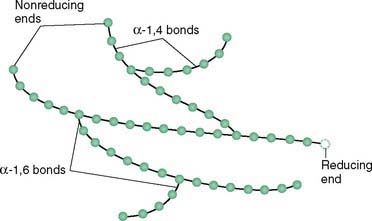Chapter 1 Carbohydrates, Lipids, and Amino Acids
Metabolic Fuels and Biosynthetic Precursors
I. Carbohydrates
A. Overview
B. Monosaccharides
1. They are aldehydes (aldoses) or ketones (ketoses) with the general molecular formula (CH2O)x, where x = 3 or more.
2. They are classified by the number of carbon atoms and the nature of the most oxidized group (Table 1-1).
a. Most sugars can exist as optical isomers (D or L forms), and enzymes are specific for each isomer.
3. Pyranose sugars (e.g., glucose, galactose) contain a six-membered ring, whereas furanose sugars (e.g., fructose, ribose, deoxyribose) contain a five-membered ring.
4. Reducing sugars are open-chain forms of five and six carbon sugars that expose the carbonyl group to react with reducing agents.
TABLE 1-1 Monosaccharides Common in Metabolic Processes
| Class/Sugar* | Carbonyl Group | Major Metabolic Role |
|---|---|---|
| Triose (3 Carbons) | ||
| Glyceraldehyde | Aldose | Intermediate in glycolytic and pentose phosphate pathways |
| Dihydroxyacetone | Ketose | Reduced to glycerol (used in fat metabolism); present in glycolytic pathway |
| Tetrose (4 Carbons) | ||
| Erythrose | Aldose | Intermediate in pentose phosphate pathway |
| Pentose (5 Carbons) | ||
| Ribose | Aldose | Component of RNA; precursor of DNA |
| Ribulose | Ketose | Intermediate in pentose phosphate pathway |
| Hexose (6 Carbons) | ||
| Glucose | Aldose | Absorbed from intestine with Na+ and enters cells; starting point of glycolytic pathway; polymerized to form glycogen in liver and muscle |
| Fructose | Ketose | Absorbed from intestine by facilitated diffusion and enters cells; converted to intermediates in glycolytic pathway; derived from sucrose |
| Galactose | Aldose | Absorbed from intestine with Na+ and enters cells; converted to glucose; derived from lactose |
| Heptose (7 Carbons) | ||
| Sedoheptulose | Ketose | Intermediate in pentose phosphate pathway |
* Within cells, sugars usually are phosphorylated, which prevents them from diffusing out of the cell.
C. Monosaccharide derivatives
1. Monosaccharide derivatives are important metabolic products, although excesses or deficiencies of some contribute to pathogenic conditions.
2. Sugar acids
b. Glucuronic acid reacts with bilirubin in the liver, forming conjugated (direct) bilirubin, which is water soluble.
4. Sugar alcohols (polyols)
a. Glycerol derived from hydrolysis of triacylglycerol is phosphorylated in the liver to form glycerol phosphate, which enters the gluconeogenic pathway.
b. Sorbitol derived from glucose is osmotically active and is responsible for damage to the lens (cataract formation), Schwann cells (peripheral neuropathy), and pericytes (retinopathy), all associated with diabetes mellitus.
D. Common disaccharides
1. Disaccharides are hydrolyzed by digestive enzymes, and the resulting monosaccharides are absorbed into the body.
E. Polysaccharides
2. Sugar polymers are commonly classified based on the number of sugar units (i.e., monomers) that they contain (Table 1-2).
TABLE 1-2 Types of Carbohydrates
| Type | Number of Monomers | Examples |
|---|---|---|
| Monosaccharides | 1 | Glucose, fructose, ribose |
| Disaccharides | 2 | Lactose, sucrose, maltose |
| Oligosaccharides | 3-10 | Blood group antigens, membrane glycoproteins |
| Polysaccharides | >10 | Starch, glycogen, glycosaminoglycans |
3. Starch, the primary glucose storage form in plants, has two major components, both of which can be degraded by human enzymes (e.g., amylase).
4. Glycogen, the primary glucose storage form in animals, has α-glycosidic linkages, similar to amylopectin, but it is more highly branched (Fig. 1-1).
a. Glycogen phosphorylase cleaves the α-1,4 linkages in glycogen, releasing glucose units from the nonreducing ends of the many branches when the blood glucose level is low.
II. Lipids
A. Overview
1. Fatty acids, the simplest lipids, can be oxidized to generate much of the energy needed by cells in the fasting state (excluding brain cells and erythrocytes).
2. Fatty acids are precursors in the synthesis of more complex cellular lipids (e.g., triacylglycerol).
B. Fatty acids
1. Fatty acids (FAs) are composed of an unbranched hydrocarbon chain with a terminal carboxyl group.
2. In humans, most fatty acids have an even number of carbon atoms, with a chain length of 16 to 20 carbon atoms (Table 1-3).
a. Short-chain (2 to 4 carbons) and medium-chain (6 to 12 carbons) fatty acids occur primarily as metabolic intermediates in the body.
(1) Dietary short- and medium-chain fatty acids (sources: coconut oil, palm kernel oil) are directly absorbed in the small intestine and transported to the liver through the portal vein.
TABLE 1-3 Common Fatty Acids in Humans
| Common Name | Carbon Chain Length: Number of Atoms |
|---|




